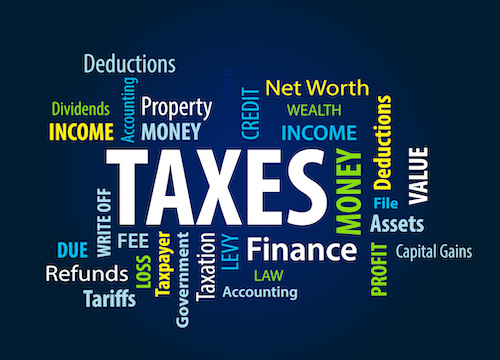“Should Congress continue to do nothing, the long-term impacts of an additional tax burden on innovation are sure to be great.”
 I was not even aware of the issue below until a CPA friend of mine happened to mention it during a friendly telephone call. But unless Section 174 of the Internal Revenue Code is restored to its previous state from prior to the 2017 Trump tax cuts, U.S. innovation will be greatly impacted.
I was not even aware of the issue below until a CPA friend of mine happened to mention it during a friendly telephone call. But unless Section 174 of the Internal Revenue Code is restored to its previous state from prior to the 2017 Trump tax cuts, U.S. innovation will be greatly impacted.
State of Play
Section 174 of the Internal Revenue Code has been around since 1954. It was enacted to eliminate uncertainty in the treatment of research and development (R&D) expenditures and to encourage businesses to carry on research and experimentation.
The 2017 Tax Cuts & Jobs Act (TCJA) removed an option that previously existed under Section 174 between fully deducting many R&D expenses in the year they were incurred and amortizing them over a 60-month period. The change went into effect in 2022, and relevant to readers of IPWatchdog, those R&D expenses include both patent costs and software development costs (in addition to salaries and wages and other R&D-related expenses). Software development costs being subject to Section 174 is actually new and also the result of the TCJA, which means those costs must now be amortized over five years as well.
What’s more, R&D expenses must still be amortized over several years even when the underlying project has been abandoned, disposed of, or retired.
The effect of the change is that a business’s tax deductions are reduced, and taxable income increased, reducing the incentive to invest in R&D in the first place. Impacted companies subject to this change range from sole proprietorships and startups to large corporate entities.
As the U.S. Chamber of Commerce put it, the impact of the TCJA on businesses is in “severely limiting their ability to continue investing in their business and threatening the competitiveness of the United States on a global scale…only two other developed countries have adopted such counterproductive policies.”
That’s exactly what we don’t need.
How We Got here
Apparently, neither party in Congress actually intended this change to take effect when it did in 2022, but making the change was the only way Congress could get their math to work the way they wanted back in 2017. Everyone just assumed they could kick the can down the road and that a subsequent Congress would work out a repeal or alteration.
Current IRS Guidance
In terms of the changes to Section 174, the IRS has provided guidance addressing the changes. Included in the guidance is a definition of what constitutes R&D expenditures subject to (amended) Section 174. The expenditures include research or experimental expenditures that (1) satisfy the requirements under Treas. Reg. Sec. 1.174-2 to be research or experimental expenditures, or (2) are made in connection with the development of any computer software as defined in the guidance.
Per Treas. Reg. Sec. 1.174-2, expenditures under Section 174 include “all such costs incident to the development or improvement of a product…[including] the costs of obtaining a patent, such as attorneys’ fees expended in making and perfecting a patent application. Expenditures represent research and development costs in the experimental or laboratory sense if they are for activities intended to discover information that would eliminate uncertainty concerning the development or improvement of a product.”
“Software” as defined by the guidance is very expansive – it includes all of the following: “[A]ny computer program or routine (that is, any sequence of code) that is designed to cause a computer to perform a desired function or set of functions, and the documentation required to describe and maintain that program or routine.” The code could be stored pretty much anywhere, including in the cloud. Relevant software includes “system software, programming software, application software, embedded software, and all forms and media in which the software is contained…Computer software also generally includes computer programs of all classes…Computer software includes software developed for use by the taxpayer in its trade or business or for sale or licensing to others.”
“Software development” as defined in the guidance is also very expansive – it includes planning the development of the computer software, designing the computer software, building a model of the computer software, writing source code and converting it to machine-readable code, and testing the computer software.
So, it would seem that pretty much every high-tech company and life sciences company will be impacted on some level by the loss of immediate R&D deductions. In fact, since certain indirect expenses like rent for R&D facilities must also now be amortized over five years, my CPA friend theorized that for a tech company that only does R&D at the moment, close to 100% of all operating costs would have to be amortized.
Bills in the Works
Various bills and non-binding budget resolutions have been proposed. None have had significant traction, though earlier this year S. 866 was introduced in the Senate, read twice and then referred to the Committee on Finance. But with much larger financial fights looming and similar bills in the House and Senate already failing in 2021, it seems as though any legislative fix is still a ways off. Maybe take small solace in the fact that this appears to be one of the exceedingly rare instances of bipartisan agreement on Capitol Hill.
Impacts So Far
Since we’re already late into 2023, the impacts are already being felt across different industries. One in-house counsel at a prominent materials company had this to say:
“The primary operational impact was to undo all accounting efforts we set up in the past so that we would properly identify capital vs regular expenses. The team was moving along processing invoices from outside counsel, and then we had to totally revisit the process. It was annoying.
The delayed expense from being a capital expense instead of a regular expense definitely causes another reason to limit patent filings (and associated expenses). I really don’t understand why policy makers would push innovators toward trade secret protection. It seems foolish from a macroeconomic standpoint.
If you consider the high interest rate environment and cost of capital these days, the delayed expense has a huge impact on valuations of SMEs. That has caused me to re-evaluate our patent filing strategy.”
But as a slight silver lining, Jason Alan Snyder, a top thought leader and futurist on artificial intelligence, mentioned this:
“As the CTO of Momentum Worldwide, an experiential marketing agency within the Interpublic Group, the shift to amortizing R&D expenses over several years, as stipulated by the 2017 Tax Cuts and Jobs Act, has ushered in a more meticulous approach to budgeting and financial planning within our organization. While this change initially posed a challenge, it has also encouraged a sharpened focus on long-term investments in innovation, ensuring that every R&D dollar is strategically allocated to drive sustainable growth and technological advancements that fortify our competitive edge in the market. The new tax framework underscores the importance of prudent financial management, fostering a culture of accountability and foresight in our R&D endeavors.”
The impacts are sure to vary from industry to industry, and there might always be too many other factors at play to ever get a true sense of the overall impact of the changes to Section 174, but the fact that many companies are already adjusting their operations in significant ways tells you all you need to know.
Longer Term Potential Impact on IP and Innovation
Should Congress continue to do nothing, the long-term impacts of an additional tax burden on innovation are sure to be great. Raw materials costs are already going up. There’s constant talk of price controls on the pharmaceutical industry, which already faces challenges with recouping R&D expenses anyway. Loss of immediate deductions for R&D would be a big double-whammy.
Additionally, as others have already written about on IPWatchdog, China’s patent eligibility laws appear to be more favorable now than those here in the U.S., and China has also seen a significant increase in R&D investment in recent years. It’s hard to see how those two things, combined with the loss of immediate R&D deductions here in the U.S., would do anything other than increase innovation in China and decrease innovation in the U.S. That’s definitely not the trend we need in U.S. innovation and the U.S. economy in general. Patent boxes in other countries might also begin to look more attractive, further diverting R&D resources that might otherwise be bound for the U.S.
If Congress is really serious about reviving U.S. manufacturing and innovation in the wake of the pandemic, fixing the TCJA changes to Section 174 would be a great place to start.
Image rights acquired by AdobeStock

![[IPWatchdog Logo]](https://ipwatchdog.com/wp-content/themes/IPWatchdog%20-%202023/assets/images/temp/logo-small@2x.png)

![[Advertisement]](https://ipwatchdog.com/wp-content/uploads/2024/04/UnitedLex-May-2-2024-sidebar-700x500-1.jpg)
![[Advertisement]](https://ipwatchdog.com/wp-content/uploads/2024/04/Artificial-Intelligence-2024-REPLAY-sidebar-700x500-corrected.jpg)
![[Advertisement]](https://ipwatchdog.com/wp-content/uploads/2024/04/Patent-Litigation-Masters-2024-sidebar-700x500-1.jpg)

![[Advertisement]](https://ipwatchdog.com/wp-content/uploads/2021/12/WEBINAR-336-x-280-px.png)
![[Advertisement]](https://ipwatchdog.com/wp-content/uploads/2021/12/2021-Patent-Practice-on-Demand-recorded-Feb-2021-336-x-280.jpg)
![[Advertisement]](https://ipwatchdog.com/wp-content/uploads/2021/12/Ad-4-The-Invent-Patent-System™.png)






Join the Discussion
One comment so far.
Jonathan Stroud
October 25, 2023 03:48 pmThis is helpful and interesting content, and I’d like to hear more.